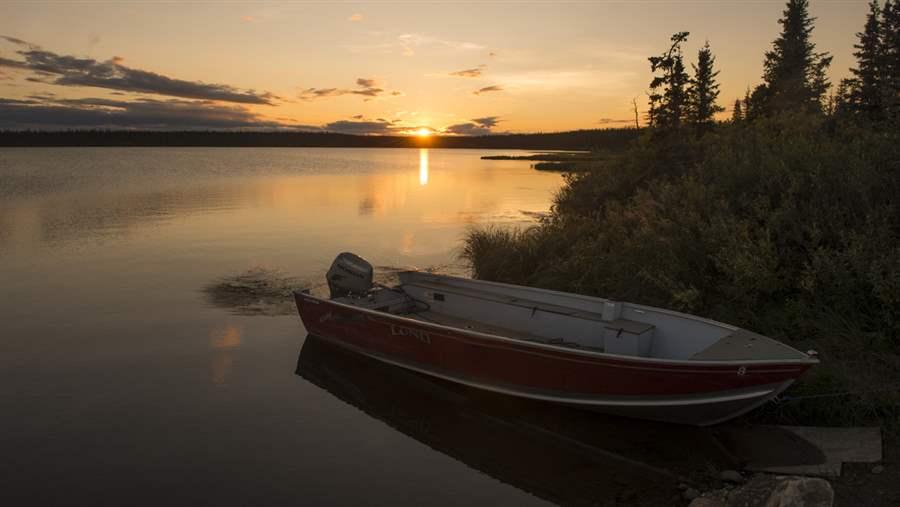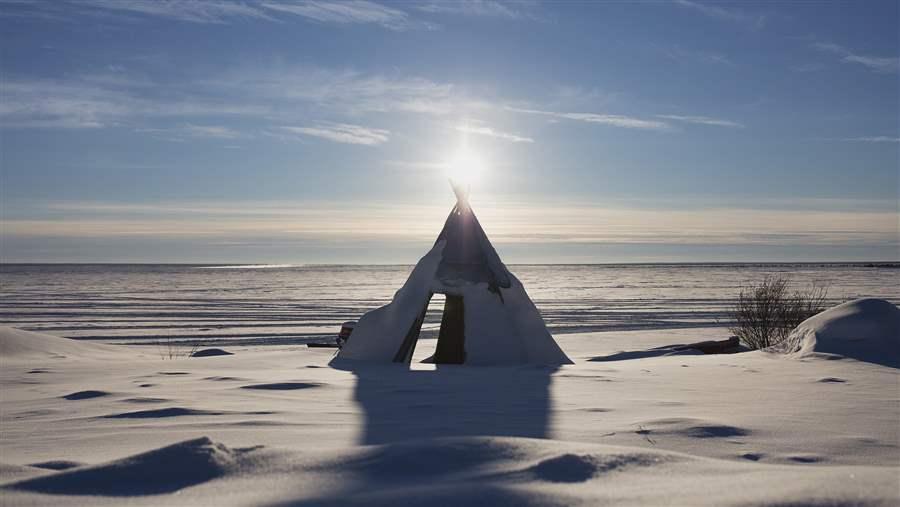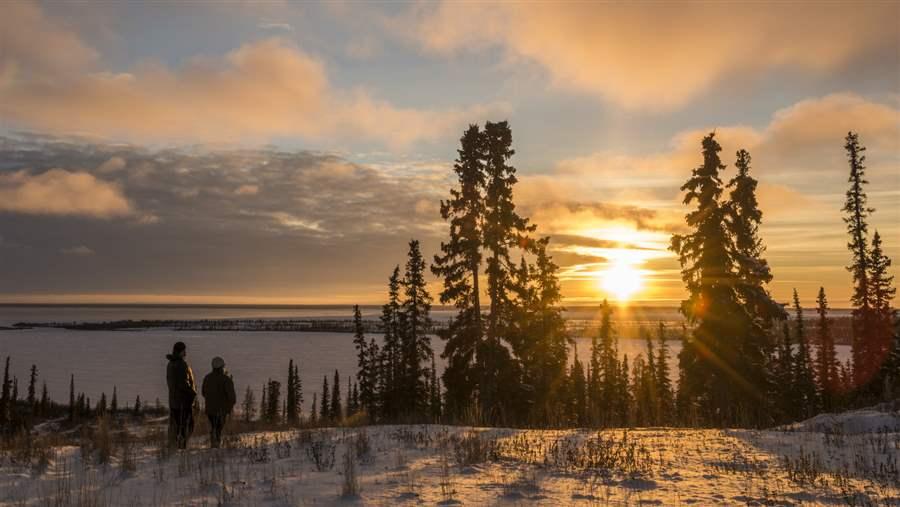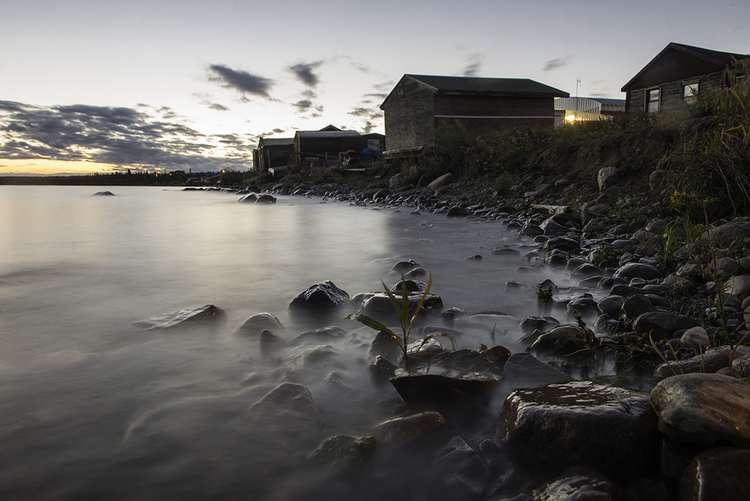Indigenous People Lead Effort to Keep ‘Water Heart’ Beating Strong in Northern Canada
UNESCO designation shines global spotlight on unpolluted waters of Great Bear Lake
 Pat Kane
Pat KaneThe evening sun reflects off the placid waters of Great Bear Lake, Northwest Territories.
For generations, the Sahtúgot’ine Dene people in northern Canada have told a story about the “water heart,” a power that connects all living things throughout their traditional territory. This heart beats deep within Great Bear Lake, a place as magnificent and untamed as its name suggests.
The largest unpolluted freshwater body in the world, Great Bear Lake straddles the Arctic Circle at the transition area between boreal forest and tundra. Its surface covers 7.7 million acres, making it the world’s eighth-largest lake by area. At an average depth of 235 feet, Great Bear Lake also holds the largest mass of cold freshwater of any lake in the world.
Its waters and shores are home to healthy populations of grizzly bears, musk ox, barren-ground caribou, wolves, and a genetically diverse population of lake trout not found in other great freshwater lakes. Vulnerable species such as the surf scoter (a type of sea duck), boreal woodland caribou, rusty blackbird, and short-eared owl find refuge in the region. The watershed includes three distinct ecozones: the taiga shield, taiga plains, and southern Arctic. Native flora range from black spruce and tamarack in forested areas to sphagnum moss in wetlands.
By any measure, the lake and its surrounding watershed is one of the last, best expanses of pristine wilderness on Earth.
Now, that value has been formally recognized: On March 19, UNESCO added the Great Bear Lake watershed to its World Network of Biosphere Reserves.
The creation of the 23-million-acre Tsá Túé International Biosphere Reserve is cause for celebration among the Sahtúgot’ine Dene, who pursued the UNESCO designation in hopes of expanding public awareness—regionally and internationally—of the watershed’s ecological importance.
The lakeshore hosts just one permanent human settlement: the 600-person Sahtúgot’ine Dene community of Délı̨nę. The community is accessible year-round only by air. A limited-season ice road connects Délı̨nę to other communities in the Northwest Territories for about three months in winter; and in summer, visitors can reach it by boat. The only signs of industrial development along the lake are the aging remnants of a few long-shuttered mines.
 Kuba Bakowski
Kuba BakowskiA lone tipi stands sentinel on the frozen shoreline of Great Bear Lake, at Délı̨nę, Northwest Territories.
While no mining has occurred for decades, the Great Bear Lake watershed is rich in natural resources, harboring deposits of coal, diamonds, iron, and copper—and possibly oil and gas reserves. Délı̨nę’s elders are acutely aware that industrial activity could return, and they want to ensure that, if it does, development will be sustainable and not harm the environment.
I recently visited Great Bear Lake as part of an international boreal conservation campaign delegation, which traveled there to learn from Délı̨nę’s elders and resource management leaders about their aspirations for conservation of the area—and to explore the potential for collaborating on that protection. Thanks to its low water temperature, relatively small drainage basin, and lack of development, the lake is so clear that, in some places, the bottom is visible almost 100 feet from the surface.
Elders and other community leaders have long sought to ensure the area’s ecological and cultural integrity, often working in partnership with other First Nations, the government of the Northwest Territories, and the Canadian federal government. The community has repeatedly demonstrated its commitment to conservation and the creation of protected areas in land claims agreements and land-use plans.
The Sahtúgot’ine Dene played a central role, for example, in developing the Great Bear Lake Watershed Management Plan and the Sahtú Land Use Plan, a larger regional plan. The plans prohibit development in core protected areas, create buffer zones where limited development can occur, and allow development elsewhere as long as it proceeds in a manner that does not threaten the watershed’s ecological health.
Several sacred and ecologically sensitive areas within the Great Bear Lake watershed, including the 1.37 million-acre Saoyú-ʔehdacho National Historic Site, are already protected.
The Great Bear Lake watershed is the first UNESCO world biosphere reserve in northern Canada, fulfilling the requirement that any designated site “promote and demonstrate a balanced relationship between humans and the biosphere.” UNESCO chooses the reserves to showcase places where conservation and sustainable economic development can coexist, and where local communities take the lead on land-use decisions.
 Pat Kane
Pat KaneA couple watches the sun set over Great Bear Lake at Délı̨nę, Northwest Territories.
In a 2015 letter supporting Great Bear Lake’s nomination, The Pew Charitable Trusts said the watershed’s designation as a world biosphere reserve “would affirm the community’s stewardship of a globally significant water source in keeping with local ecological, cultural, and spiritual values, and facilitate Délı̨nę’s central role in managing responsible economic development in the region.”
Dene elders “see the many rivers, streams, and creeks that flow into and out of [Great Bear Lake] as fulfilling the same functions as the veins, capillaries, and arteries in the bodies of all creatures,” according to the Great Bear Lake Watershed Management Plan, which outlines the conservation ethic that guides the people of Déline.
“The elders assert that the health of people and the land are directly connected—and that the people are not in reality separate from the land and other creatures,” according to the watershed plan. “They want to protect it so that it can be used by the present generation and by future generations.”
 Pat Kane
Pat KaneMist rises off the still waters of Great Bear Lake, at Délı̨nę, Northwest Territories.
By designating the Great Bear Lake watershed as a world biosphere reserve, UNESCO is shining a global spotlight on an important model for local, indigenous-led management. The designation will help both the Sahtúgot’ine Dene and the government of the Northwest Territories plan a future that ensures sound management of natural resources and the protection of areas of enormous environmental and spiritual value.
That is good news not only for the people of Canada’s north but also for the health of a planet where clean air and water have become increasingly precious commodities.
Jennifer Lamson is director of The Pew Charitable Trusts’ international boreal conservation campaign.






